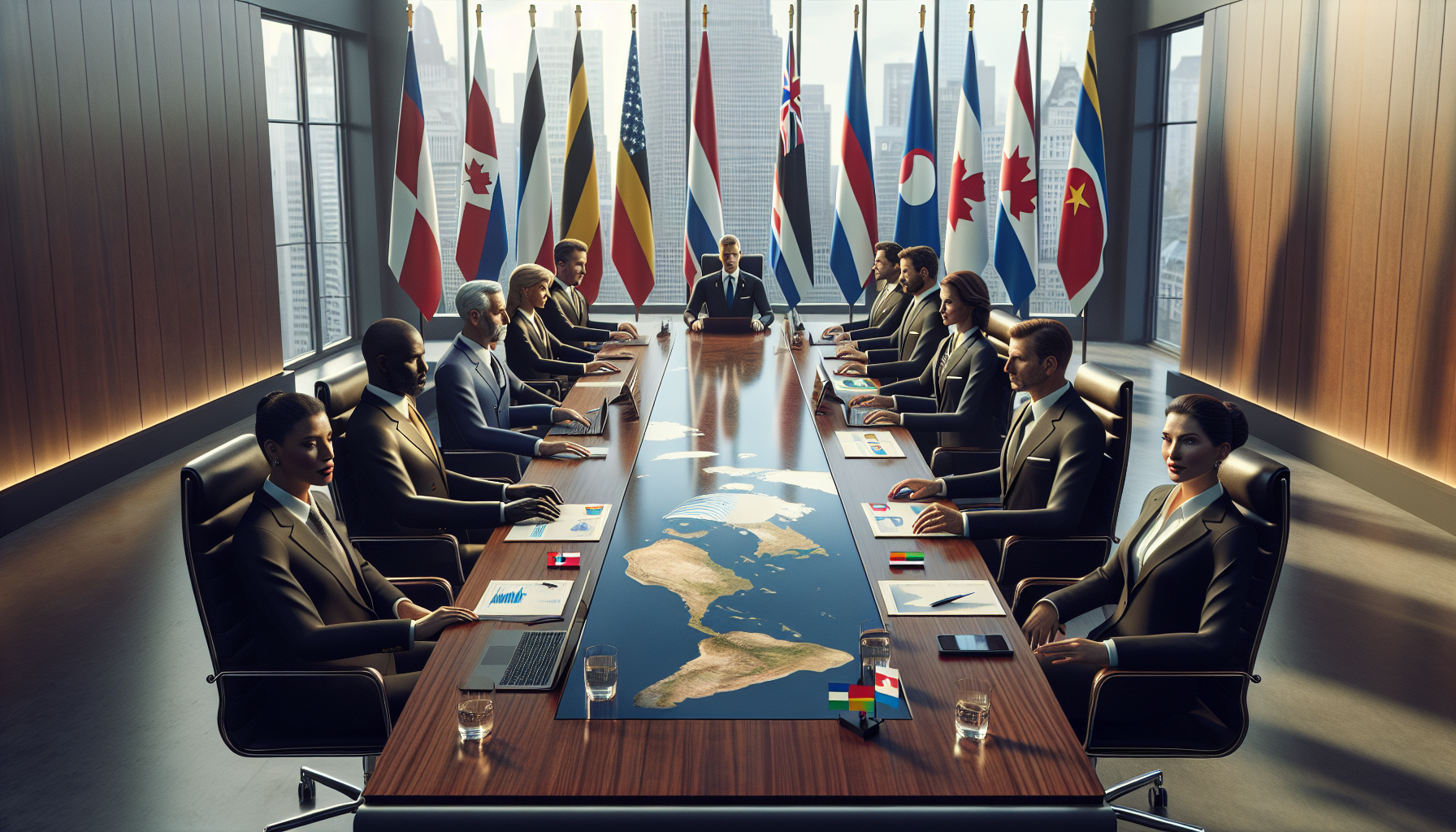In the intricate tapestry of global politics, where nation-states often dominate the narrative, there exists a fascinating and lesser-known phenomenon—micronations. These are self-proclaimed entities, often small in size but rich in ambition, that assert their independence and distinct identities despite lacking international recognition. While at first glance, they may appear as eccentric footnotes in the annals of geopolitics, micronations possess a unique charm and a latent potential that is beginning to unfold in surprising ways. As the world becomes increasingly interconnected, these diminutive sovereignties are discovering the power of unity, giving rise to a new paradigm: the formation of micronational alliances. This collective strategy is not only enhancing their visibility but also amplifying their influence on the global stage, proving that size is not always synonymous with strength. 🌍
This blog post delves into the transformative impact of these micronational alliances, exploring how they are reshaping perceptions, fostering cooperation, and even challenging traditional diplomatic practices. We will embark on a journey through the history and motivations behind the creation of micronations, uncovering the diverse array of cultures, ideologies, and aspirations that drive them. From environmental advocacy to cultural preservation, micronations often serve as laboratories of innovation and progress. By banding together, they pool resources, share knowledge, and amplify their voices, effectively punching above their weight in international discussions. Throughout this exploration, we will highlight key examples of successful alliances, examining how they have navigated the complex dynamics of diplomacy and what lessons they offer for the broader global community.
The Rise of Micronations: A Brief Overview
In recent years, the concept of micronations has garnered attention from enthusiasts and scholars alike. Micronations are small, self-proclaimed entities that claim independence but lack recognition from world governments and major international organizations. They often form as a means of political experimentation, personal amusement, or cultural expression. Despite their lack of official recognition, micronations play a unique role in the geopolitical landscape, offering a glimpse into the diverse ways individuals and communities assert their identity and governance ideals.
Micronations vary greatly in size, structure, and purpose. Some are vast digital communities, while others are tangible, with territory, infrastructure, and residents. For example, the Principality of Sealand, located on a former sea fort off the coast of England, and the Republic of Molossia, a desert enclave in Nevada, USA, have established elaborate governmental systems, complete with passports, currencies, and constitutions. These micronations, while often founded as whimsical endeavors, challenge conventional notions of statehood and sovereignty.
The allure of micronations lies in their ability to experiment with governance without the constraints imposed by traditional nation-states. They provide a sandbox for testing new political ideas and fostering a sense of community among like-minded individuals. As such, they attract people with diverse motivations, ranging from political activists seeking reform to hobbyists indulging in creative expression. This diversity has led to the formation of numerous alliances and networks among micronations, enhancing their ability to influence global discourse in unique ways.
Understanding the Motivations Behind Micronationalism
The motivations behind the creation of micronations are as varied as the entities themselves. Political experimentation is a common driving force. Many founders see micronations as an opportunity to implement governance models they believe are superior to those of existing states. This might include the promotion of direct democracy, alternative economic systems, or unique cultural traditions. By creating a microcosm of society, these visionaries can test their ideas in a controlled environment, free from external pressures and bureaucratic constraints.
For others, the creation of a micronation is an artistic or cultural endeavor. These individuals may be inspired by historical events, fictional works, or personal experiences, leading them to establish a nation that reflects their passions and values. This approach often results in micronations that emphasize cultural identity and heritage, with elaborate rituals, symbols, and narratives that bind members together. Such micronations serve as a form of storytelling, providing an immersive experience for participants and observers alike.
In addition to political and cultural motivations, some micronations are established as a form of protest or resistance. By declaring independence and forming a new nation, these entities make bold statements about the perceived failures of existing governments or international bodies. This act of defiance can draw attention to issues such as environmental degradation, human rights abuses, or economic inequality. While their lack of formal recognition limits their influence, these micronations can raise awareness and spark dialogue on critical global issues.
Forming Alliances: A Strategy for Global Influence
While individual micronations may struggle to exert significant influence on the global stage, alliances between them can amplify their voices and impact. By joining forces, micronations can pool resources, share expertise, and coordinate efforts to advance their collective interests. This collaborative approach enhances their ability to participate in international discourse and advocate for change, both within their own communities and beyond.
One of the primary benefits of forming micronational alliances is the ability to share resources and knowledge. Many micronations lack the financial and human capital to pursue large-scale projects independently. By collaborating with others, they can access a wider pool of resources, including funding, technology, and expertise. This enables them to undertake initiatives that would otherwise be beyond their reach, such as environmental conservation projects, cultural exchange programs, or diplomatic missions.
Moreover, alliances provide a platform for micronations to learn from one another’s successes and challenges. Through regular communication and collaboration, micronations can exchange best practices and innovative solutions, enhancing their governance and operational capabilities. This knowledge sharing fosters a sense of community and solidarity among micronations, encouraging mutual support and collective growth. Watch the video below to learn more about successful micronational alliances: Understanding Micronational Alliances – Micronation Channel
The Role of Technology in Facilitating Alliances
In today’s digital age, technology plays a crucial role in facilitating micronational alliances. The internet provides a global platform for communication and collaboration, enabling micronations to connect with one another regardless of geographic distance. Social media platforms, online forums, and virtual conferences allow micronational leaders and citizens to interact, share ideas, and coordinate efforts in real-time.
These technological advancements have democratized access to information and resources, empowering micronations to organize and mobilize more effectively. For instance, virtual communication tools enable micronations to hold meetings and discussions without the need for physical travel, reducing costs and logistical barriers. Additionally, online platforms facilitate the dissemination of information and advocacy efforts, allowing micronations to reach a wider audience and raise awareness about their causes.
However, reliance on technology also presents challenges. Cybersecurity threats, misinformation, and digital divides can hinder collaboration and undermine trust among micronations. To address these challenges, micronations must prioritize digital literacy and security, ensuring that their members are equipped to navigate the complexities of the digital landscape. By leveraging technology responsibly and strategically, micronations can enhance their alliances and amplify their influence on the global stage.
Challenges and Opportunities in Micronational Diplomacy
While micronational alliances offer numerous benefits, they also face significant challenges. One of the primary obstacles is the lack of formal recognition from established nation-states and international organizations. This lack of recognition limits micronations’ ability to participate in official diplomatic channels and engage with the global community on equal footing. As a result, micronations must find creative ways to assert their presence and influence in international affairs.
Despite these challenges, micronations have opportunities to engage in diplomacy and advocacy through informal channels. Cultural diplomacy, for example, allows micronations to showcase their unique identities and foster cross-cultural understanding. By organizing cultural events, exhibitions, and exchanges, micronations can build bridges with other communities and promote their values on the global stage. Such efforts can enhance their soft power and increase their visibility in the international arena.
Another avenue for micronational diplomacy is participation in international networks and forums. While micronations may not have official status, they can still engage with like-minded organizations and advocacy groups to advance common goals. By collaborating with non-governmental organizations (NGOs), academic institutions, and civil society groups, micronations can amplify their voices and contribute to global discussions on issues such as human rights, environmental sustainability, and social justice.
Building a Shared Vision: The Future of Micronational Alliances
As micronations continue to navigate the complexities of diplomacy and alliance-building, the development of a shared vision becomes increasingly important. By articulating common goals and values, micronations can strengthen their alliances and enhance their collective impact. This shared vision should be inclusive and adaptable, reflecting the diverse perspectives and aspirations of participating micronations.
To build a shared vision, micronations must engage in open and inclusive dialogue, fostering a culture of collaboration and mutual respect. This involves actively listening to the voices of all members, addressing concerns and challenges, and finding common ground on key issues. By prioritizing transparency and accountability, micronations can build trust and cohesion within their alliances, creating a strong foundation for collective action.
Ultimately, the success of micronational alliances will depend on their ability to balance individual autonomy with collective solidarity. By embracing diversity and innovation, micronations can position themselves as dynamic actors in the global landscape, leveraging their unique perspectives and strengths to effect positive change. As the world continues to evolve, micronations have the opportunity to redefine the boundaries of statehood and governance, challenging traditional norms and inspiring new possibilities for global cooperation. 🌍

Conclusion
In conclusion, the article “Unite and Conquer: The Power of Forming Micronational Alliances for Global Influence” has explored the fascinating and often underestimated world of micronations and their potential to impact global discourse through strategic alliances. Throughout the text, we’ve delved into several key points that underscore the viability and importance of these alliances.
Firstly, we examined the definition and characteristics of micronations, those intriguing entities that, while not officially recognized as sovereign states, embody the spirit of nationhood with their own governance, culture, and ambitions. These micronations, although small in size and population, are not without influence. Their unique position allows them to experiment with governance and cultural practices that might be impossible in larger, more established nations.
The article then highlighted the strategic significance of forming alliances among micronations. By uniting, these entities can amplify their voices and share resources, thereby gaining a more substantial presence on the global stage. This coalition-building enables micronations to influence global conversations, advocate for niche interests, and contribute to international dialogue in innovative ways.
Furthermore, we discussed various case studies where micronational alliances have successfully brought attention to global issues. For example, through coordinated efforts, these alliances have managed to address environmental concerns, cultural preservation, and technological innovations, demonstrating their capacity to effect real change despite their limited size. This illustrates the concept that the power of collaboration can often transcend the sum of individual efforts.
The potential of micronational alliances also extends to fostering a sense of community and shared identity among participating nations. By collaborating, micronations can celebrate their unique cultures while finding common ground, thus promoting peace, understanding, and mutual respect on a broader scale.
Importantly, the article addressed the challenges these alliances face, such as limited resources, political recognition, and internal disagreements. However, it also proposed practical solutions to these challenges, including leveraging digital platforms for communication, engaging in cultural diplomacy, and developing innovative governance structures that allow for flexibility and resilience.
In reinforcing the importance of this topic, it is crucial to acknowledge that in an increasingly interconnected world, the contributions of all entities, regardless of size, can have far-reaching implications. Micronational alliances exemplify how cooperation and unity can pave the way for novel approaches to global challenges. Their experiences provide valuable lessons in diplomacy, governance, and collaboration that can inspire both small and large nations alike.
As we wrap up this exploration, I encourage you, the reader, to reflect on the role that micronations and their alliances might play in shaping the future. Could the principles of micronational cooperation be applied to larger international relationships? How can traditional nations learn from the innovative practices of these small entities?
Feel free to share your thoughts and insights in the comments section below. Let’s continue this conversation and explore how unity and collaboration, even among the smallest players, can indeed conquer challenges on a global scale. 🌍
*Please note that the links provided are for illustrative purposes. Ensure they direct to active and relevant content before sharing.*
Toni Santos is a visual storyteller and artisan whose creations celebrate the poetry of the natural world. Through his thoughtful artistic lens, Toni captures the elegance of botanical forms, transforming them into meaningful expressions of symbolism, resilience, and timeless beauty.
His journey is deeply rooted in a passion for flora and the mysteries they carry. From the shape of a petal to the curve of a vine, each design Toni brings to life reflects a deeper narrative — one of growth, transformation, and harmony with nature. Whether crafting symbolic floral jewelry, enchanted botanical illustrations, or seasonal visual studies, Toni’s work evokes the quiet magic found in Earth’s most delicate details.
With a background in handcrafted artistry and visual design, Toni blends technique with intention. His creations do more than decorate — they speak, often inspired by ancient meanings behind flowers, the cycles of the seasons, and the invisible bonds between nature and spirit.
As the creative voice behind Vizovex, Toni shares this botanical journey with the world, offering curated stories, handcrafted collections, and thoughtful articles that help others reconnect with nature’s symbolism and artistic essence.
His work is a tribute to:
The quiet power of flowers and their messages
The art of visual symbolism in everyday life
The beauty of slowing down to see what’s hidden in plain sight
Whether you’re an artist, a nature lover, or someone drawn to the deeper meanings behind the natural world, Toni welcomes you to explore a space where aesthetics meet soul — one petal, one story, one creation at a time.





